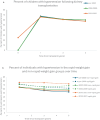Rapid Weight Gain After Pediatric Kidney Transplant and Development of Cardiometabolic Risk Factors Among Children Enrolled in the North American Pediatric Renal Trials and Collaborative Studies Cohort
- PMID: 39729540
- PMCID: PMC11677067
- DOI: 10.1111/petr.70005
Rapid Weight Gain After Pediatric Kidney Transplant and Development of Cardiometabolic Risk Factors Among Children Enrolled in the North American Pediatric Renal Trials and Collaborative Studies Cohort
Abstract
Introduction: Given the risks of cardiovascular disease among pediatric kidney transplant recipients, we evaluated whether there was an association between rapid weight gain (RWG) following kidney transplantation and the development of obesity and hypertension among children enrolled in the North American Pediatric Renal Trials and Collaborative Studies (NAPRTCS) registry.
Methods: This retrospective analysis of the NAPRTCS transplant cohort assessed for RWG in the first year post-transplant and evaluated for obesity and hypertension in children with and without RWG up to 5 years post-transplant. We evaluated three separate eras (1986-1999, 2000-2009, and 2010-2021). We performed chi-square and logistic regression analyses to assess cardiometabolic risk at three time points (1, 3, and 5 years post-transplant).
Results: The percent of children with RWG decreased across the three eras (1986-1999 37.3%, 2000-2009 23.0%, and 2010-2021 16.4%). Obesity was significantly more common among children with a history of RWG following transplant, with 48%-67% with RWG having obesity 5 years following transplant compared with 22%-25% without RWG. Hypertension was significantly more common in the RWG group than the non-RWG group at all but two time points. In logistic regression models, the odds of obesity in the RWG group compared with non-RWG was 2.55 (2.29-2.83), and the odds of hypertension were 1.00 (0.94-1.08). Steroid minimization protocols were associated with significantly less RWG.
Conclusions: RWG was significantly associated with obesity but not hypertension among pediatric kidney transplant recipients enrolled in NAPRTCS. Interventions targeting RWG following kidney transplant should be evaluated as a potential way to modify obesity rates following transplantation.
© 2024 The Author(s). Pediatric Transplantation published by Wiley Periodicals LLC.
Conflict of interest statement
The authors declare no conflicts of interest.
Figures



References
-
- Workeneh B., Moore L. W., Nolte Fong J. V., Shypailo R., Gaber A. O., and Mitch W. E., “Successful Kidney Transplantation Is Associated With Weight Gain From Truncal Obesity and Insulin Resistance,” Journal of Renal Nutrition 29 (2019): 548–555. - PubMed
-
- Wilson A. C., Greenbaum L. A., Barletta G. M., et al., “High Prevalence of the Metabolic Syndrome and Associated Left Ventricular Hypertrophy in Pediatric Renal Transplant Recipients,” Pediatric Transplantation 14 (2010): 52–60. - PubMed
-
- el‐Agroudy A. E., Wafa E. W., Gheith O. E., Shehab el‐Dein A. B., and Ghoneim M. A., “Weight Gain After Renal Transplantation Is a Risk Factor for Patient and Graft Outcome,” Transplantation 77 (2004): 1381–1385. - PubMed
-
- Kaur K., Jun D., Grodstein E., et al., “Outcomes of Underweight, Overweight, and Obese Pediatric Kidney Transplant Recipients,” Pediatric Nephrology 33 (2018): 2353–2362. - PubMed
MeSH terms
LinkOut - more resources
Full Text Sources
Medical

